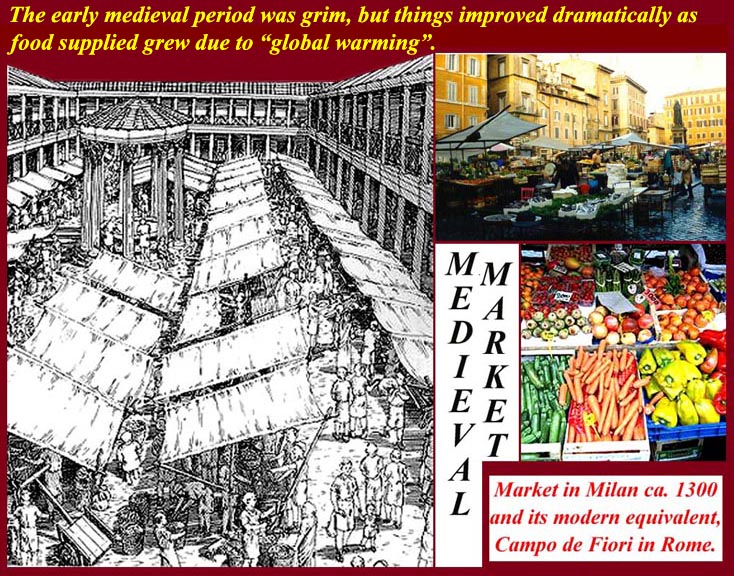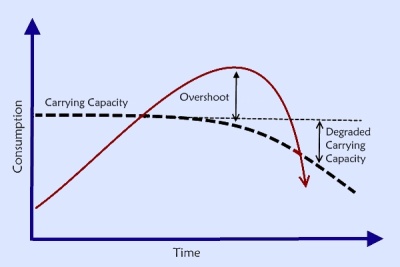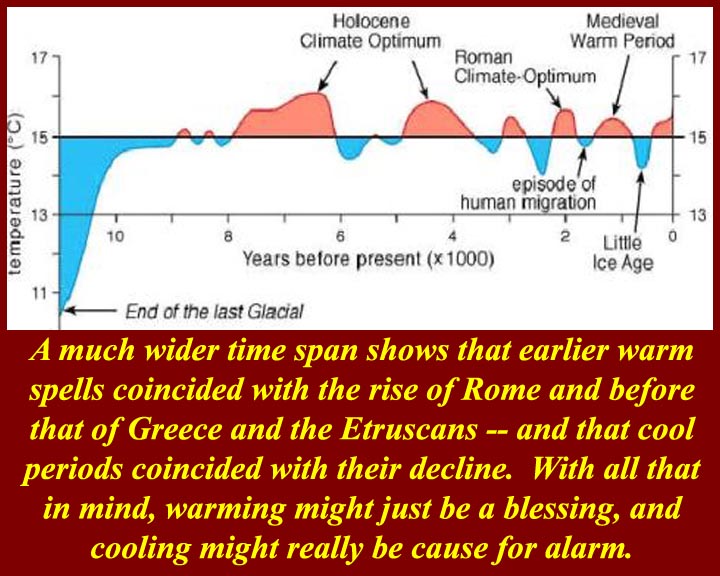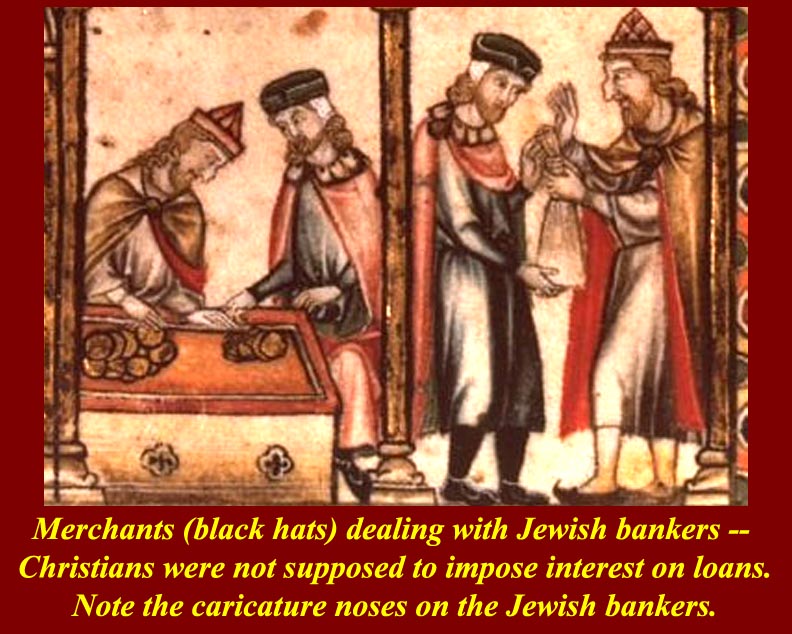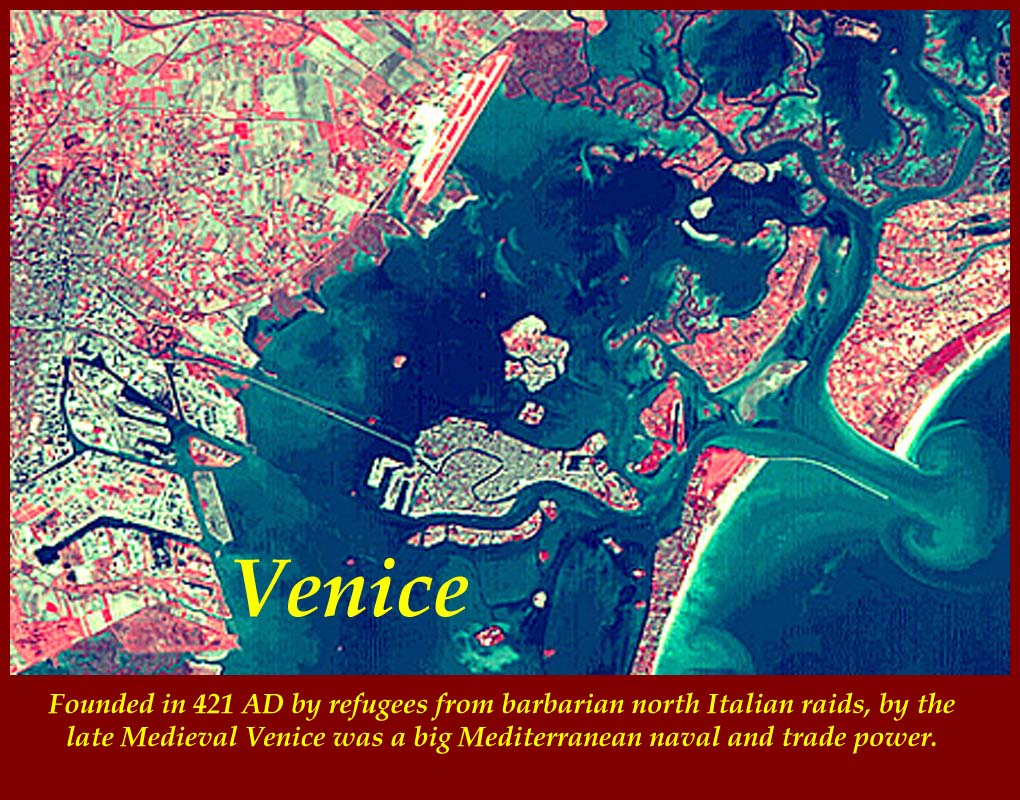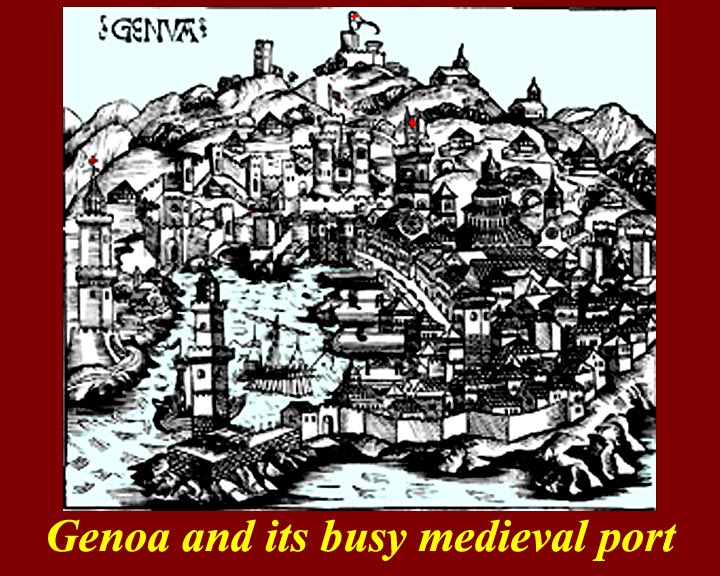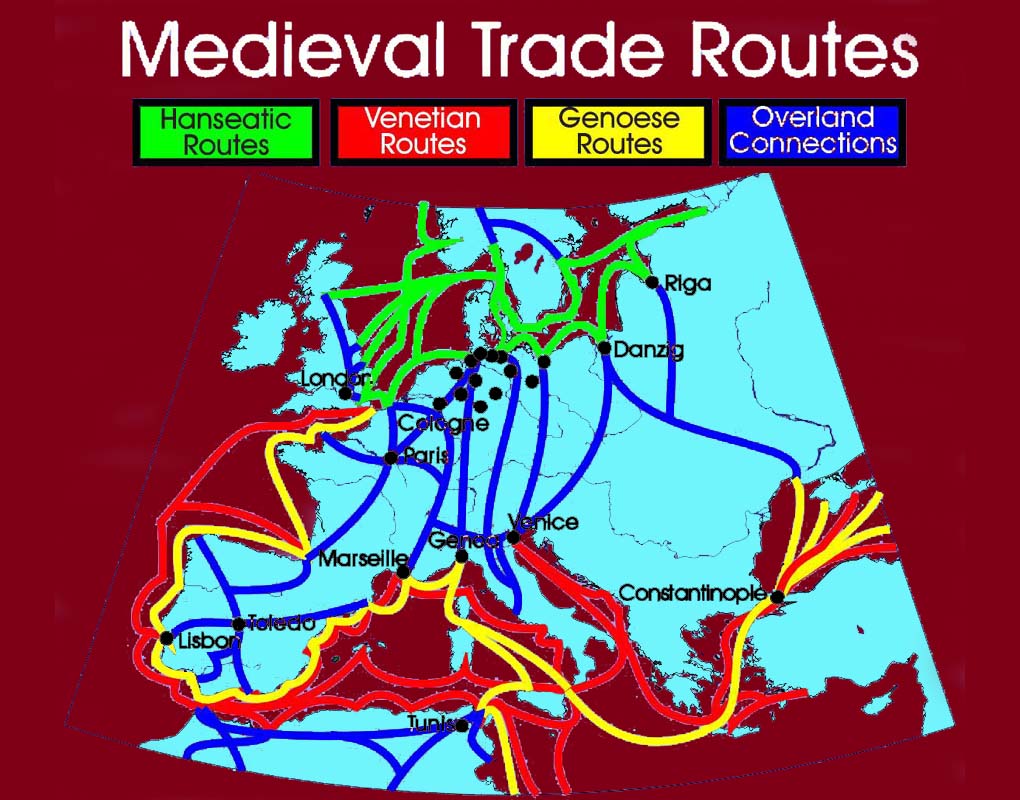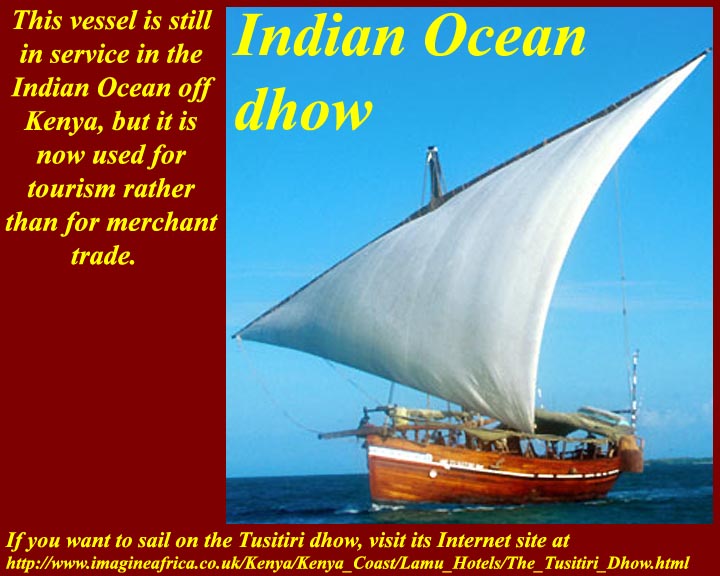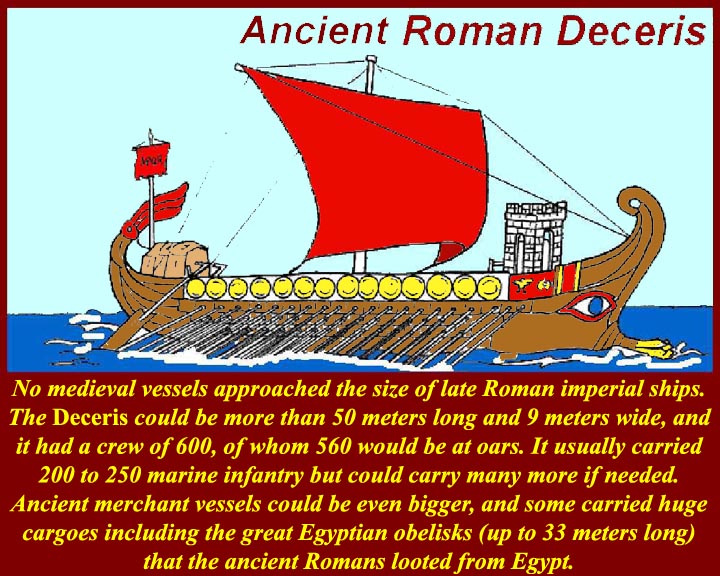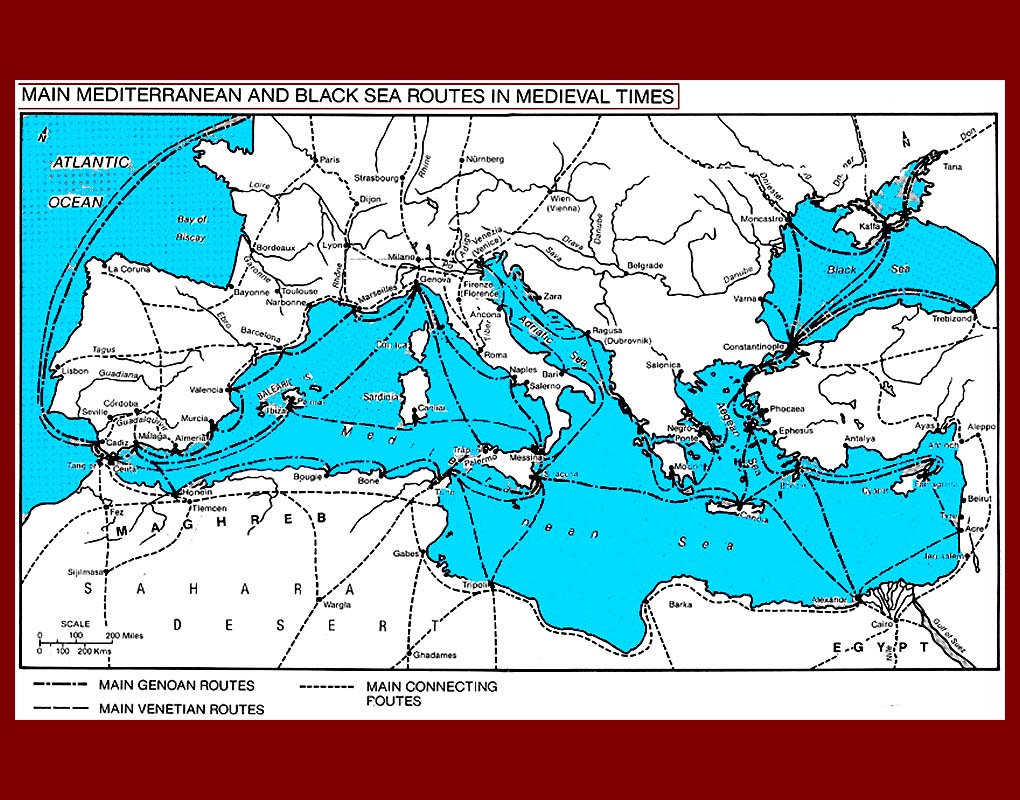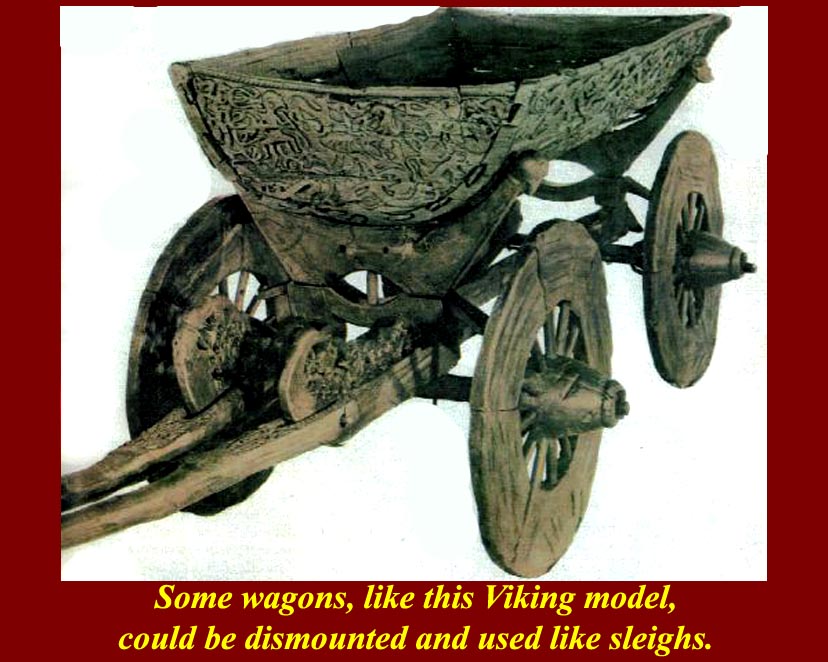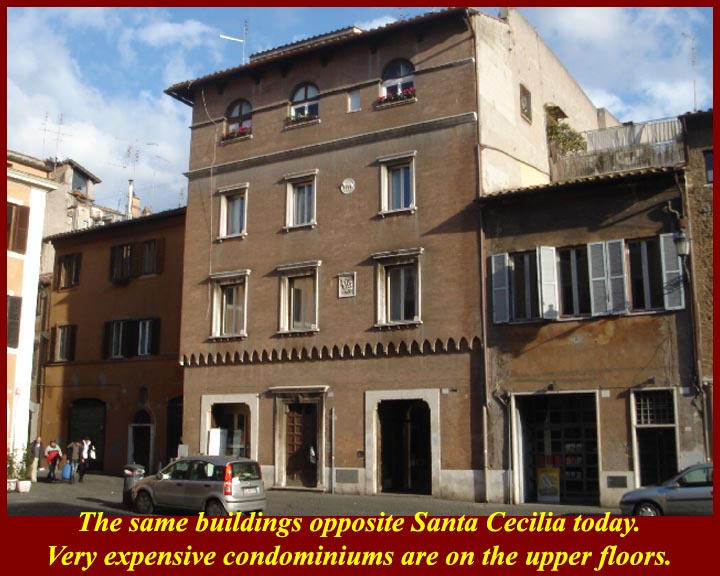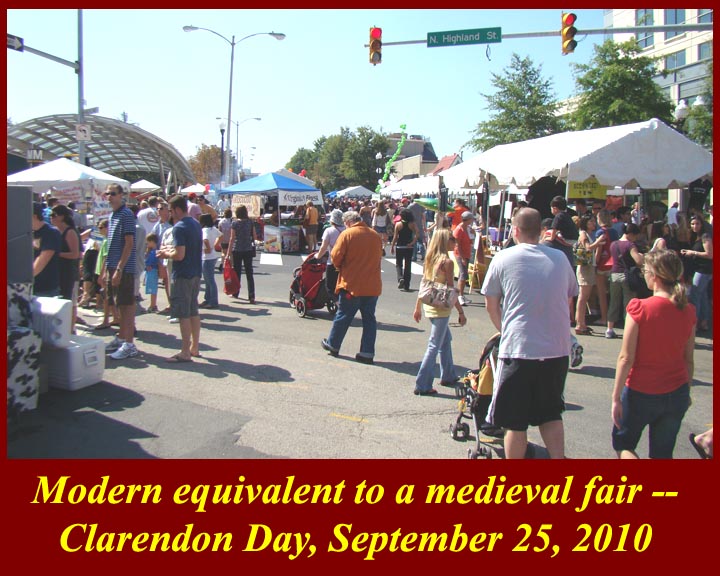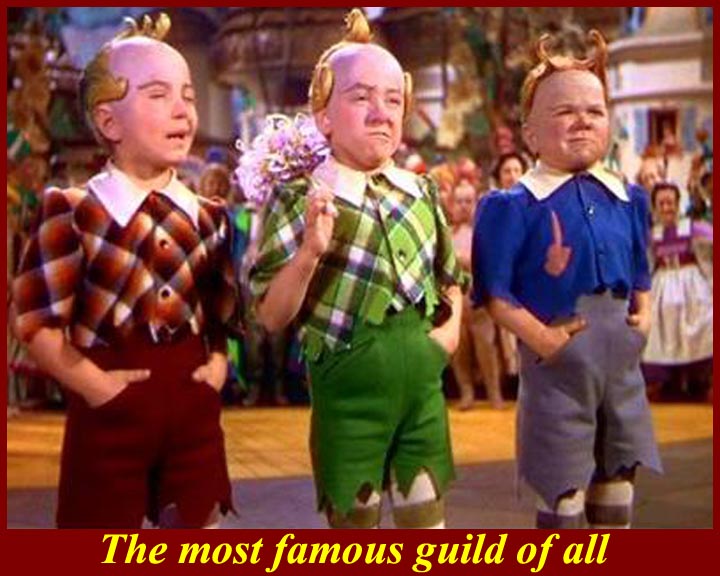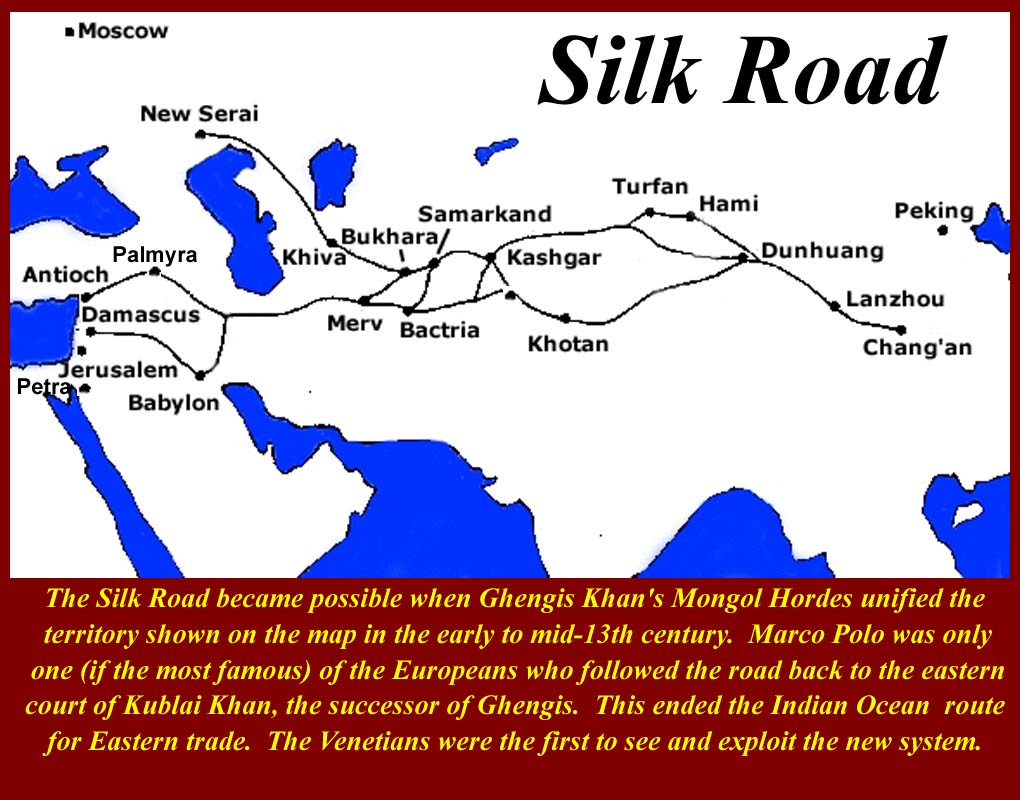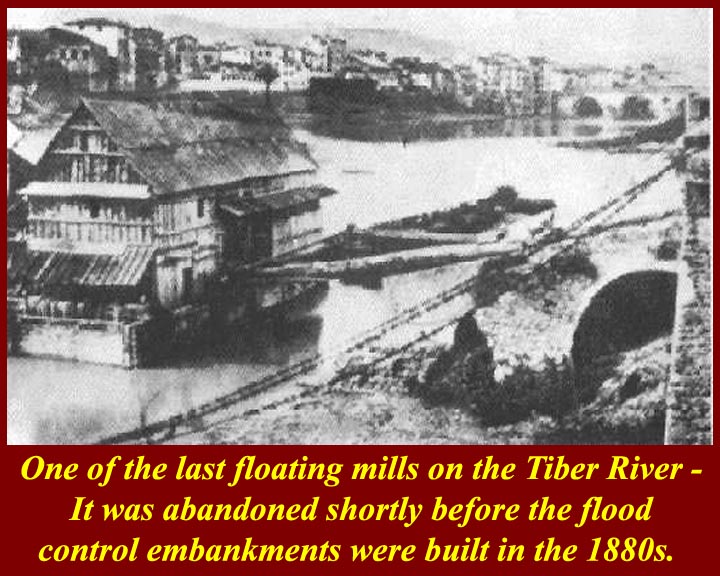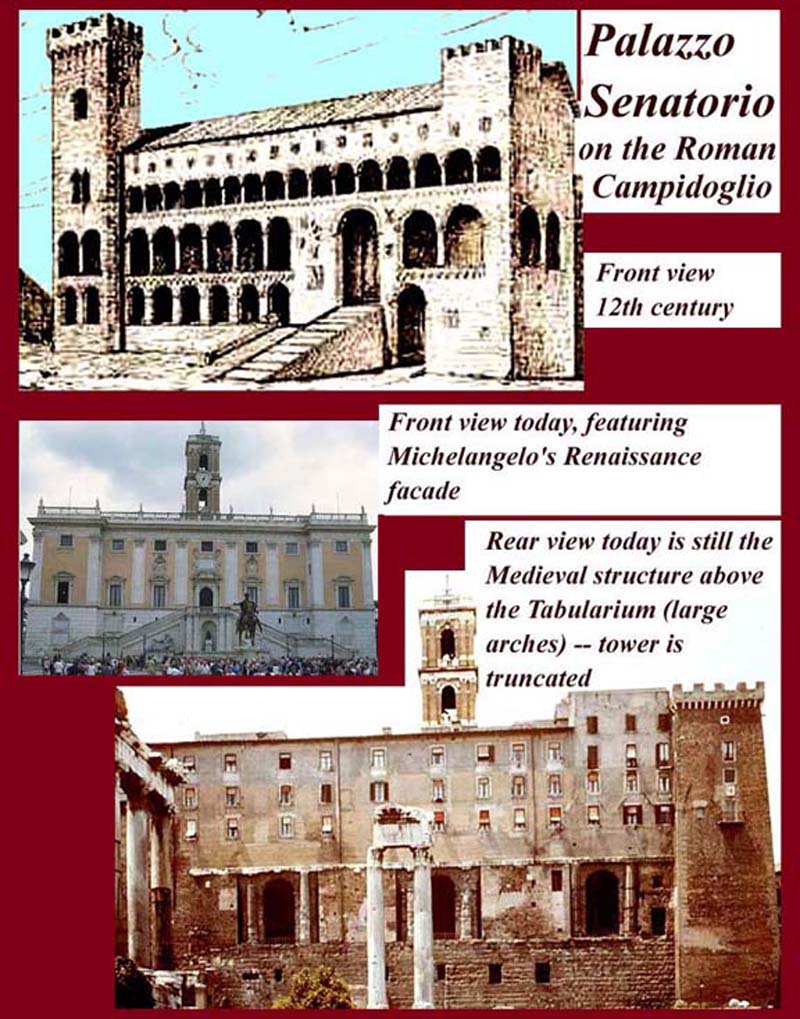Medieval Roman EconomyClick on links or small images below to go to larger images for Unit 7
http://www.mmdtkw.org/MedRom0701MedievalMarket.jpg
Liebig's Law of the Minimum, often simply called Liebig's Law or the Law of the Minimum, is a principle developed in agricultural science by Carl Sprengel (1828) and later popularized by Justus von Liebig. It states that growth is controlled not by the total of resources available, but by the scarcest resource (limiting factor). In subsistence societies, i.e., in societies where all or very close to all of the population lives at the subsistence nourishment level, the limiting factor for the total possible population number is almost always the availability of food.
'"Asking 'How will we get enough food to feed this growing population?' is a lot like asking 'How will we get enough wood to feed this growing bonfire?'"
The point of the quote is that most people have the ecological cause and effect of food and population exactly backwards. The real problem is not that a rising population requires more food, but that an increasing food supply drives populations ever upward. See http://www.paulchefurka.ca/Population%20Limits.html for more of an article expounding this theory. It may or may not be correct, but it is something to think about.
Many population theorists believe that population grew dramatically during the "Medieval warm period", because the warmer climate made it possible to grow more food.
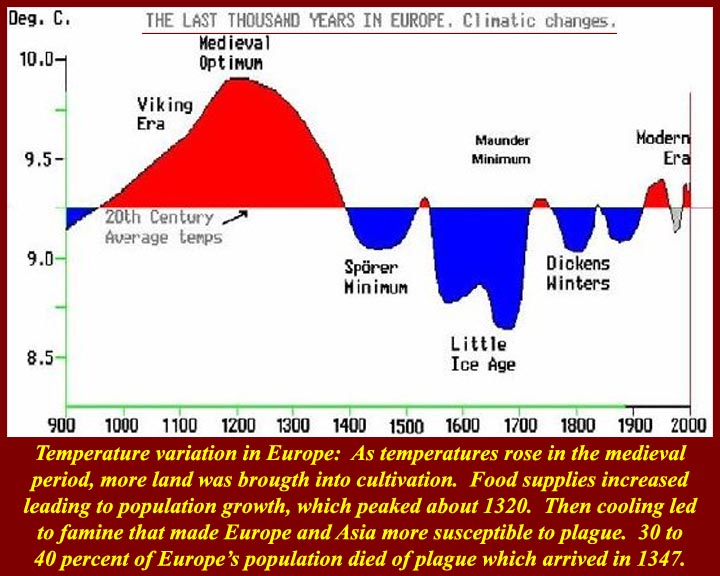
http://www.mmdtkw.org/MedRom0701xMedievalWarm.jpg
http://www.mmdtkw.org/MedRom0701yWarmPeriods.jpg
Warming in medieval Europe (and, according to paleometeorologists, at the same time in other parts of the world) lengthened growing seasons by about 20 percent and made more land available for cultivation. Food supplies increased in Europe leading to population growth which peaked about 1320. Cooling and fluctuating rainfall patterns that followed the warm period led to famine that, in turn, made Europe and Asia more susceptible to plague. The population of Europe was already in decline due to famine when the Black Plague entered Europe in 1347. Thirty to forty percent of Europe's population died as a result of plague. The period that we are studying is the prosperous period before the famine and plague. For theories about the cause of the cooling, see http://earthsky.org/earth/volcanoes-might-have-triggered-the-little-ice-age. Possible consequences of the cooling (including invention of the bicycle) are listed at http://www.history.com/news/little-ice-age-big-consequences.
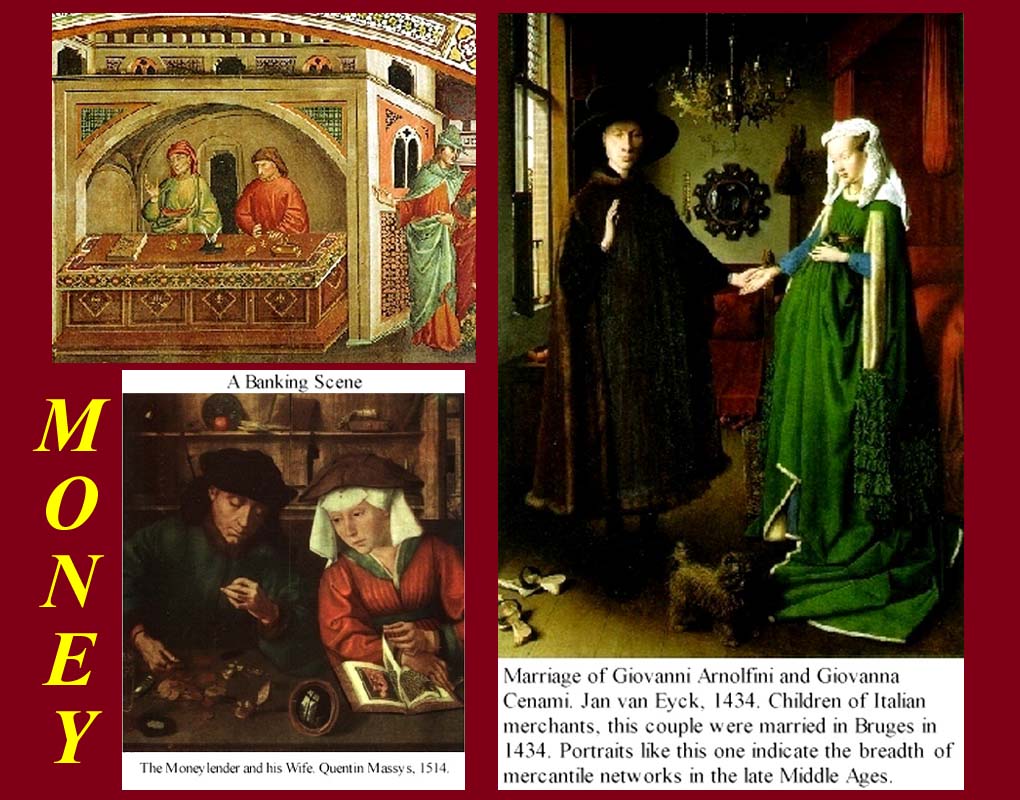
http://www.mmdtkw.org/MedRom0702BankingMoney.jpg
http://www.mmdtkw.org/MedRom0702xBankingLoans.jpg
Economic development works like this: First somebody rises above the subsistence level and trades his excess for some token representing that excess. (We call the token money.) Then somebody realizes that money under the mattress can be used to buy luxuries or can be lent at interest to make more money. Borrowers show up with a need for cash. There are a few details like division of labor, fair trade, supply and demand, etc. That's the whole thing.
For a look at the details, see http://www.fordham.edu/halsall/sbook1j.html.
People who accumulated money (first cash and then promises of cash) could lend , and thus banking was born.
See http://englishhistoryauthors.blogspot.com/2012/06/money-lending-in-middle-ages.html and
http://www.unc.edu/~salemi/Econ006/Lopez.pdf and http://www.faculty.umb.edu/gary_zabel/Courses/Phil%20281b/Philosophy%20of%20Magic/Dante.%20etc/Philosophers/End/bluedot/banking.html
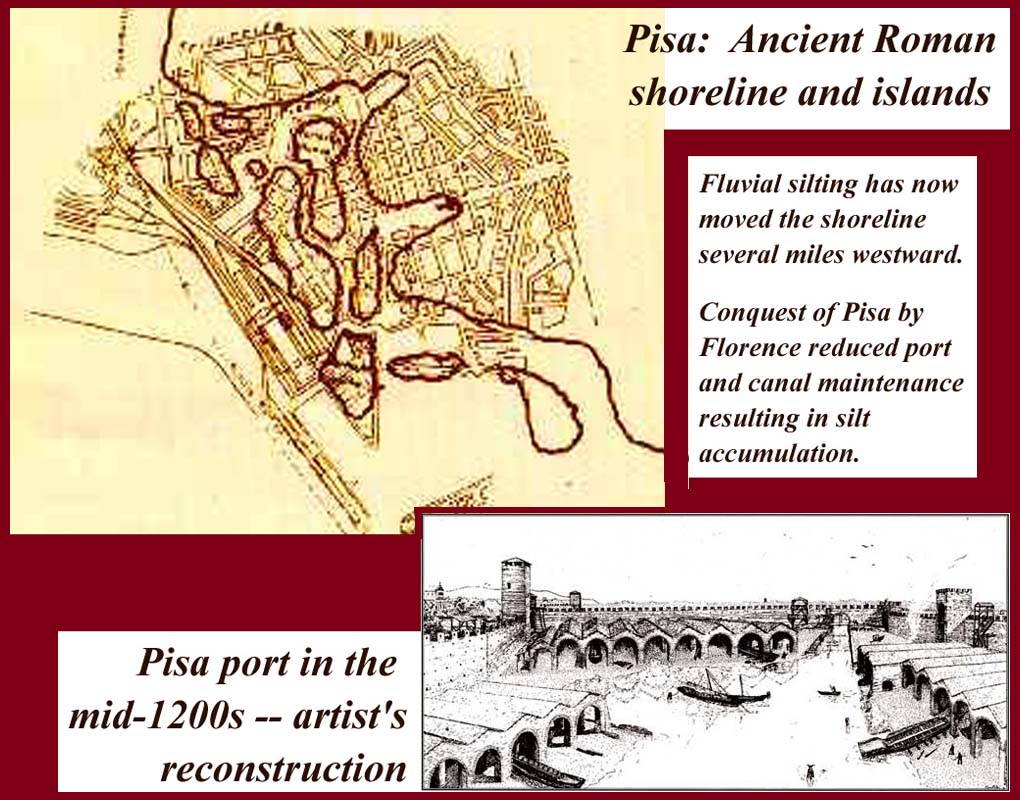
http://www.mmdtkw.org/MedRom0703PisaShoreline.jpg
http://www.mmdtkw.org/MedRom0703x.jpg
Italy's coastal cities became shipping centers for exports and imports. Very quickly they learned that they also had to have military fleets to defend their trade -- mostly against piracy. The Venetians added a sideline, the transportation of Crusaders. In the late medieval period, the Venetians used the crusaders of the Fourth Crusade to loot Constantinople.
The medieval Pisa port has silted over and the old coastline is now in dry land. The new port is further west. Excavations near the train station has exposed a number of ships in the old port and revealed much information about Medieval trade. The Venice port is still active, but gates to prevent flooding of the city have the potential to cause the whole Venice lagoon to silt up. (An even more serious possibility is that an earthquake could liquefy the semi-plastic clay under the island city and cause it to sink quickly below the surface.)
In medieval times and later, the Venetians were known as master traders and were often accused of also being master traitors. Their pattern was to trade with anyone if profit was available, and sometimes to trade with both sides in disputes. By the time of Charlemagne, Venice was divided into three factions, one that supported the continued relationship that Venice had developed with Constantinople, a second which wanted to break ties with Constantinople and act independently (free agency), and a third pro-papal which preferred to develop a new relationship with the Franks, in line with papal policy. A smaller group thought it politic to forgo distant relationships and to maintain peace with the neighboring (and surrounding, but for the sea) Lombards, but that idea was overtaken by events when the Lombards were ousted by the Franks.
In the early middle ages, Venice began to establish its own naval power and itself became a player, assisting the Byzantines against the Arabs and helping to suppress piracy. The Venetians were active participant in the Crusades from the start, attacking coastal cities in the Levant and transporting crusaders. As noted above, the Venetians diverted the Fourth Crusade and used it to conquer Constantinople. They claimed most of the loot, much of which is still on display in Venice, including the four bronze horses said to have been made by Lysippos. The Venetians set the horses above the entrance to the Basilica of St. Mark (but they are now inside behind the choir loft). St. Mark's supposed bones (along with his supposed patronage) had earlier been looted by the Venetians from Alexandria.
For the further naval/commercial exploits of the Venetians, see
http://en.wikipedia.org/wiki/Republic_of_Venice.
For St Mark in Venice, see http://en.wikipedia.org/wiki/St_Mark's_Basilica.
For the peripatetic horses, see http://www.mmdtkw.org/VHorses2002.html.
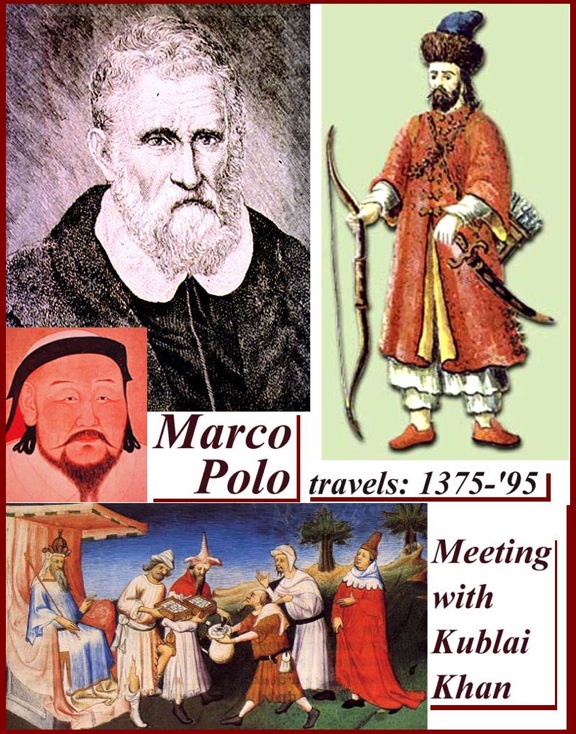
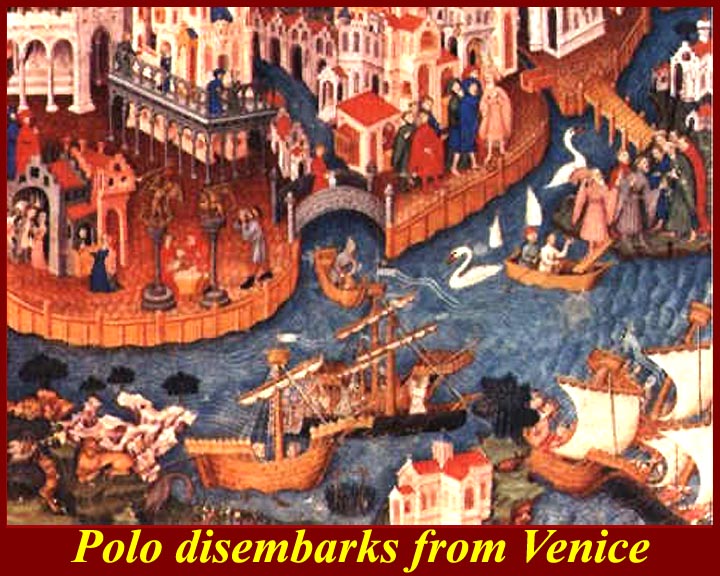
http://www.mmdtkw.org/RenRom0129-MarcPolo.jpg
http://www.mmdtkw.org/MedRom0703yVenicePoloDeparts.jpg
Venice looked far afield for markets and products, and Venetian commercial adventurers went out on distant expeditions. The most famous were the Polos, two generations of whom traveled along the Silk Road to the far east. They were not, of course, the only travelers in that direction, but rather they practiced the most efficient press agentry. The adventures of the Polo's and Marco Polo's story are well enough known in their general outline that there is no need to list them here.
If you want more on the travels of the Polos, see
http://en.wikipedia.org/wiki/Marco_Polo,
http://www.silk-road.com/artl/marcopolo.shtml, and
http://geography.about.com/cs/marcopolo/a/marcopolo.htm, which has links to several additional articles.
English translations of the entire text of the two volumes of The Travels of Marco Polo are on the Internet at http://www.gutenberg.org/etext/10636 (Volume I) and
http://www.gutenberg.org/etext/12410 (Volume II).
http://www.mmdtkw.org/MedRom0703zGenoa.jpg
Italy's third great Medieval port was Genoa.
More than you ever will need to know about Genoa is on the internet at
http://www.pages.pomona.edu/~glg04747/genoa/index.htm.
The part of that web site that deals with the Genoese economy is at
http://www.pages.pomona.edu/~glg04747/genoa/genoa3.htm.
http://www.mmdtkw.org/MedRom0704aTradeRoutes.jpg
Main medieval European and North African land and sea trade routes.
The land routes followed old Roman-built roads except those shown the farthest east in the image. [Those eastern routes went down rivers and were established by Norse traders. Those eastern Vikings were called Russ, and Moscow was one of their trading towns -- Viking coins have been found in Constantinople and in Jerusalem.] The European sea routes were also along trade seaways established by the Romans. There were, of course, also connections to the Middle East and beyond. Both Genoa and Venice established trading centers on the Syrian coast, which connected them to the Silk Road all the way to China.
See http://www.medieval-life-and-times.info/medieval-life/medieval-trade-italy.htm.
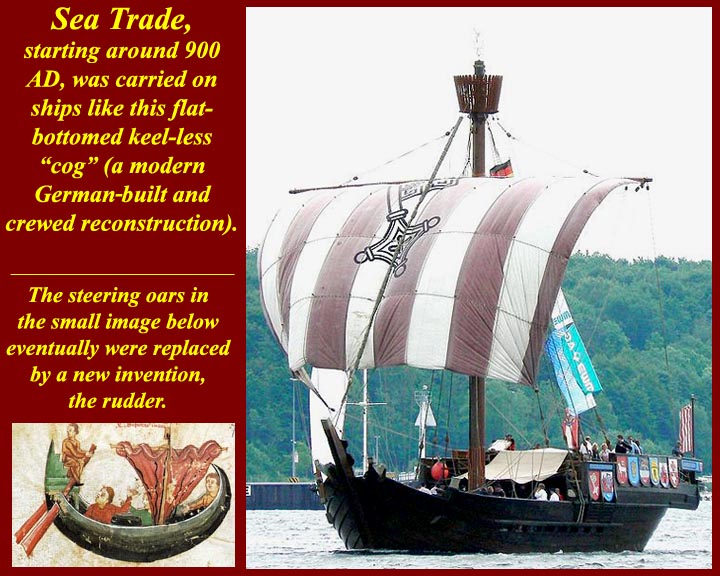
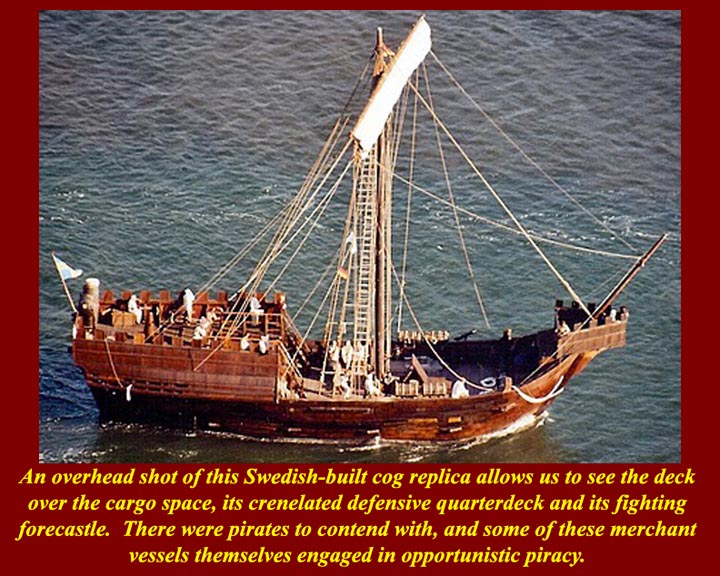
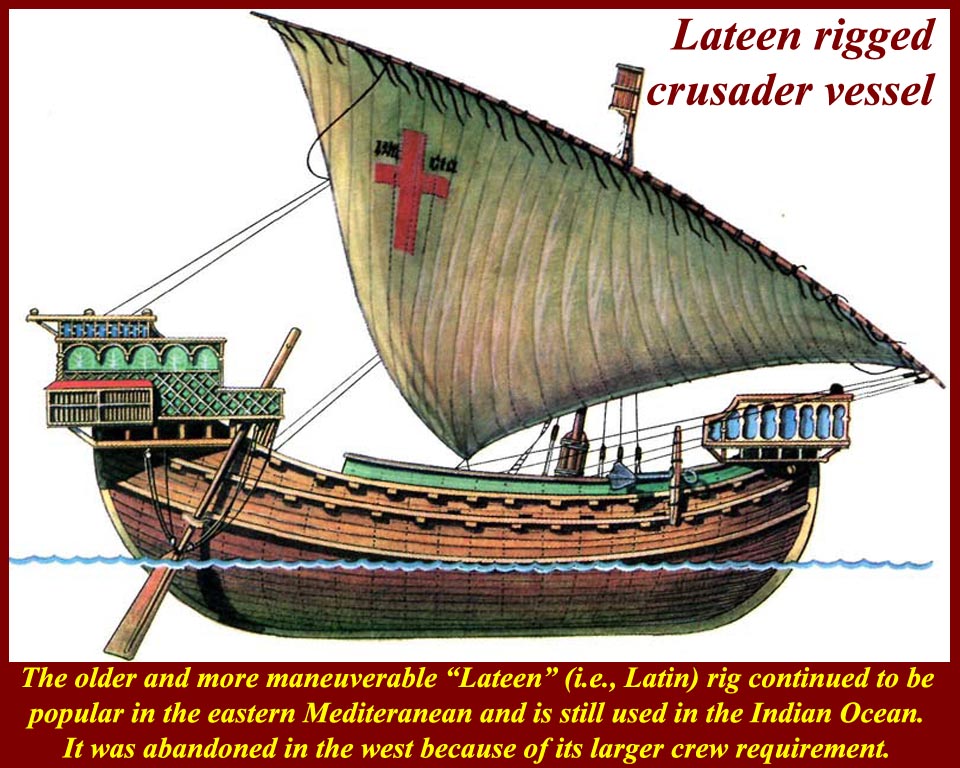
http://www.mmdtkw.org/MedRom0704bCogShip.jpg
http://www.mmdtkw.org/MedRom0704cCogOverhead.jpg
http://www.mmdtkw.org/MedRom0704dLateenRig.jpg
http://www.mmdtkw.org/MedRom0704eIndianOceanDhow.jpg
Medieval style trading vessels. The cog, the standard type of medieval European trading vessel, was square rigged with a single upright mast. It had a small area below decks and much more space for deck cargo. A quarter deck in the rear (i.e., in the quarter) roofed over officers quarters and administrative areas and provided a higher area for steering and lookouts. It might have a fighting platform in the front which was called a forecastle. The lateen rig (from "Latin"), on the same type of hull as the cog, was still used in the Middle East in medieval times and was more maneuverable than the square rigged vessels used by European traders. The mast on a lateen rigged ship was raked forward to balance the weight of the sail and spar as they were swung behind the mast. The advantage of the square rig was that it required a smaller crew than did the Lateen rig. Lateen rig is still used in the Red Sea and Indian Ocean dhows and on feluccas on the Nile river.
For the Cog, see
http://en.wikipedia.org/wiki/Cog_(ship).
For the Lateen rigged vessel, see
http://en.wikipedia.org/wiki/Lateen.
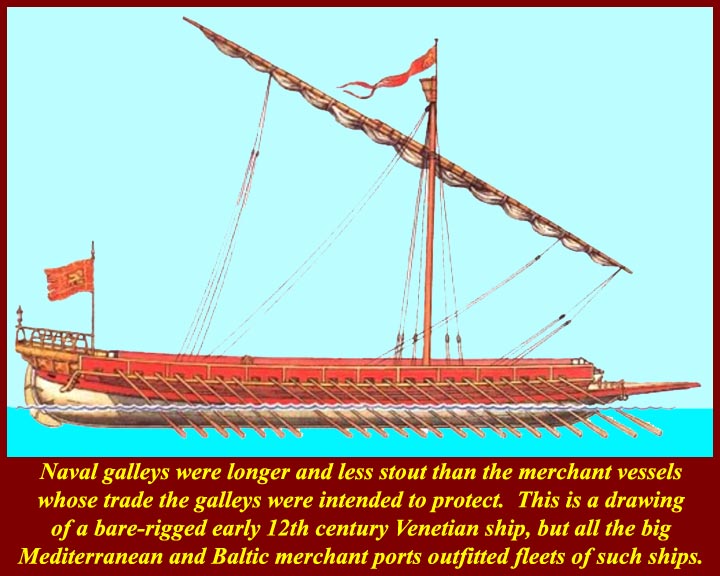
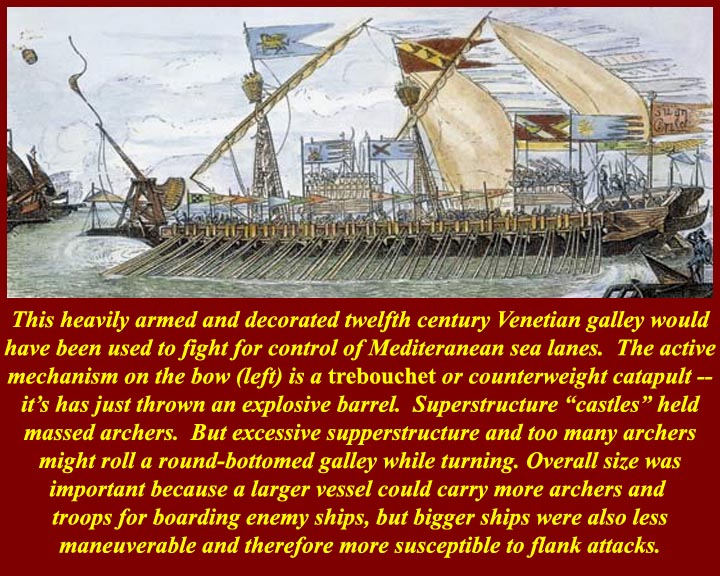
http://www.mmdtkw.org/MedRom0704fNavalGalley.jpg
http://www.mmdtkw.org/MedRom0704gVenetianGalley.jpg
http://www.mmdtkw.org/MedRom0704hAncientDeceris.jpg
All Mediterranean trading states, at least from the 8th century BC, developed naval forces to protect their commercial shipping, and the common name for the naval ship was the galley. Larger Byzantine vessels of essentially the same design were called dromons. In Medieval times, these ships were equipped with oars and sails and were manned by free crew members. Only later were they crewed with of slave and prisoner oarsmen. None of the Medieval vessels approached the size of the lat Roman Empire vessel, the deceris -- a dromon might approach its length, but the deceris was a wider and higher vessel.
Galley: http://en.wikipedia.org/wiki/Galley
Dromon: http://en.wikipedia.org/wiki/Dromon and, for a US Naval Academy PowerPoint production on Medieval sea war,
https://www.usna.edu/Users/history/abels/hh381/Medieval%20War%20Ships%20and%20Naval%20War.ppt.
http://www.mmdtkw.org/MedRom0704iTradeRoutes2.jpg
Another map of medieval Mediterranean sea trade routes showing connections through the Middle East.
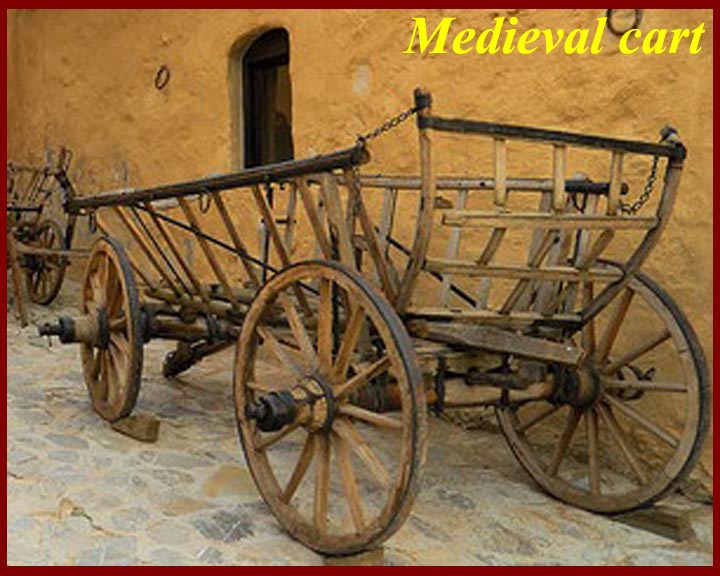
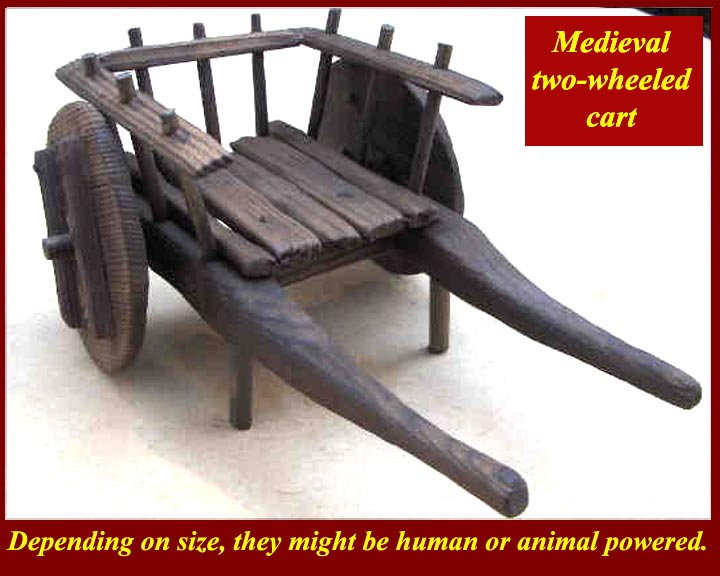
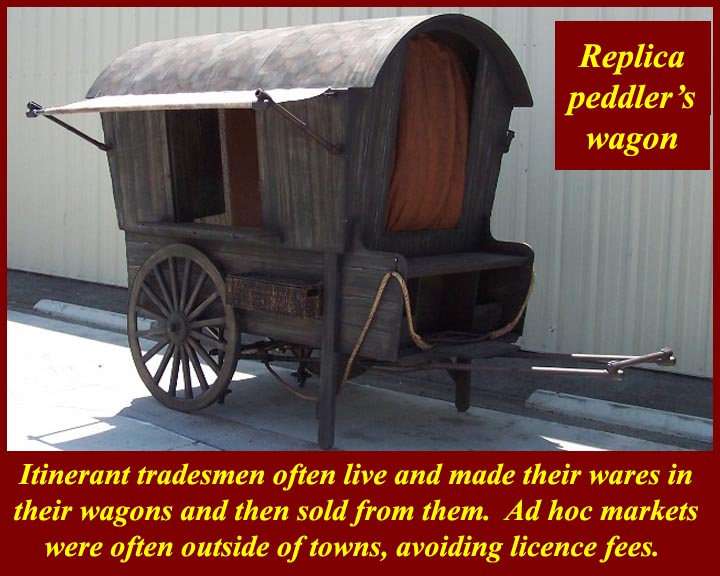
http://www.mmdtkw.org/MedRom0704jMedievalWagon.jpg
http://www.mmdtkw.org/MedRom0704k2Wheeled.jpg
http://www.mmdtkw.org/MedRom0704lTradesmanWagon.jpg
http://www.mmdtkw.org/MedRom0704mCart.jpg
There was little advancement in land transportation during medieval times. Four wheeled vehicles still had fixed front axles. Heavy loads were pulled by oxen and lighter loads by donkeys. Small carts could be human powered. The Viking cart, known as the Oseberg cart was part of the grave-goods of a Viking ship-burial from the southeast of Norway. The Ship, the cart, and other artifacts from the burial are in the Viking Ship Museum in Bygd°y, a peninsula on the western side of Oslo.
Medieval carts were degraded Roman carts. See
http://www.humanist.de/rome/rts/wagon.html.
For the viking cart, see
http://www.sjolander.com/viking/museum/m/cart.htm .
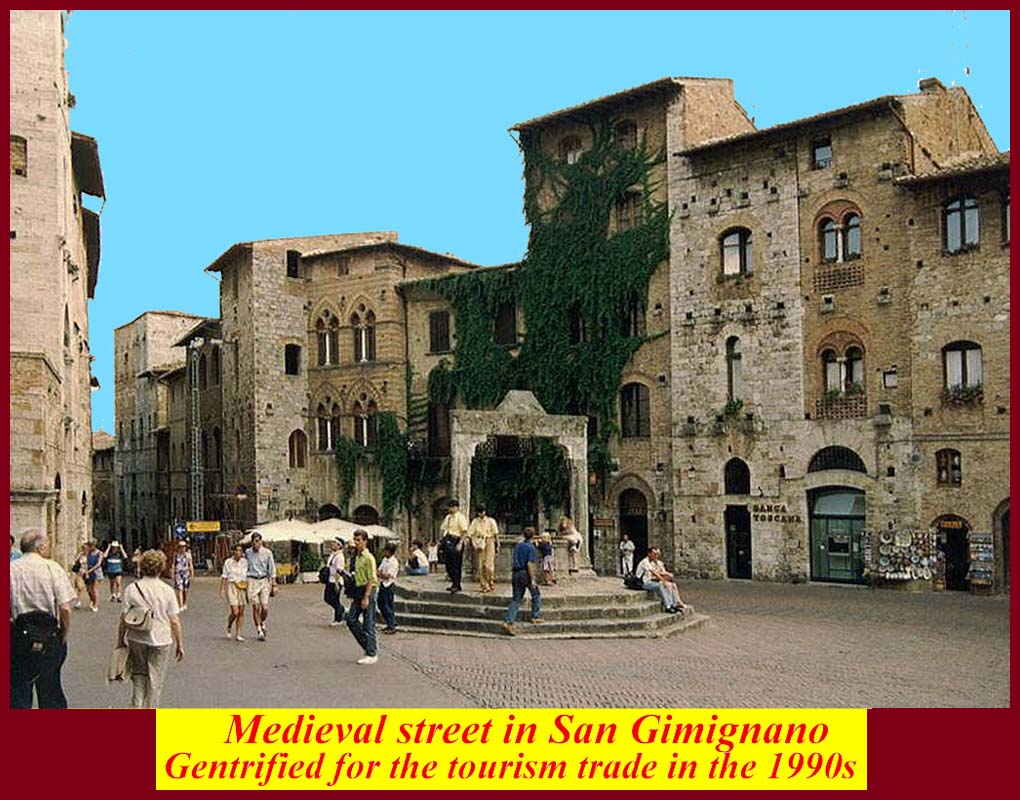
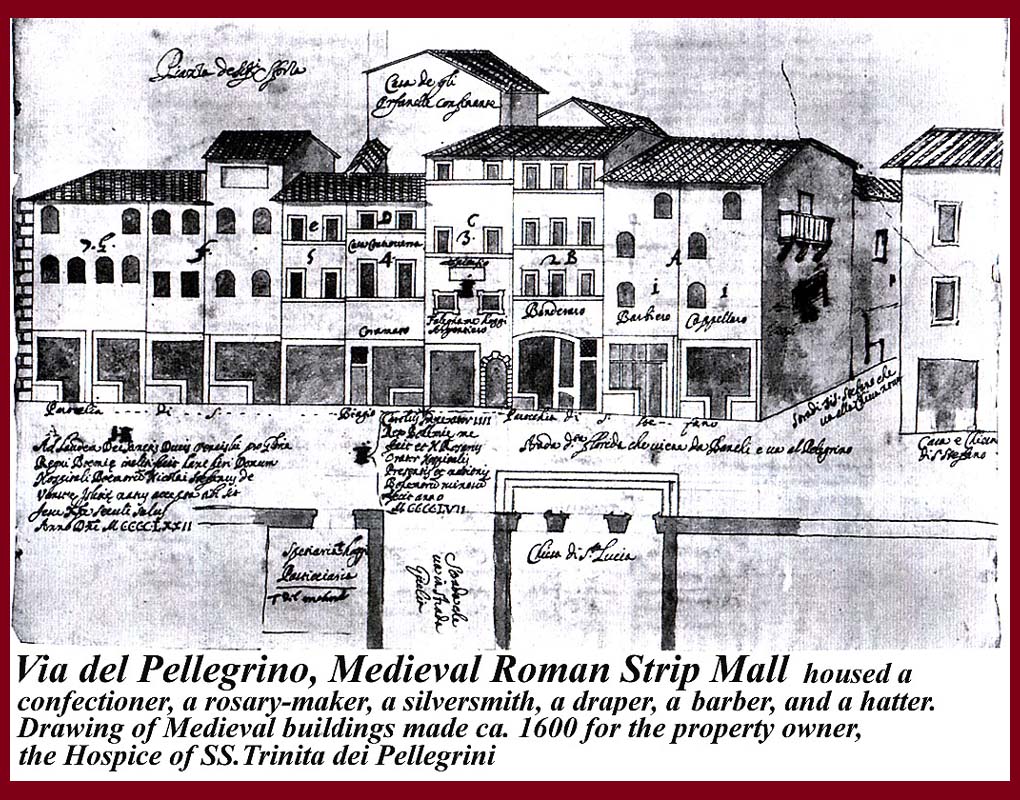
http://www.mmdtkw.org/MedRom0705SGimignano.jpg
http://www.mmdtkw.org/MedRom0706ViaPellegrino1600.jpg
http://www.mmdtkw.org/MedRom0707PellegrinoNow.jpg
Tradesmen sold their wares and services in "strip-malls" on piazze in towns and cities -- often opposite municipal buildings or churches. The first image shows the main square (= piazza) in the Italian town of San Gimignano, a place pretty much bypassed by renaissance reconstruction. The town now sees this as an advantage; it attracts tourists eager for the medieval experience. Of course the shops now are all high-end boutiques and fast food outlets.
The second image is a renaissance cadastral document showing the stores and shops opposite the Santa Cecilia Church and the Hospice of Santi Trinita dei Pellegrini in Rome's Trastevere district. The third image shows the same group of shops opposite Santa Cecelia today.
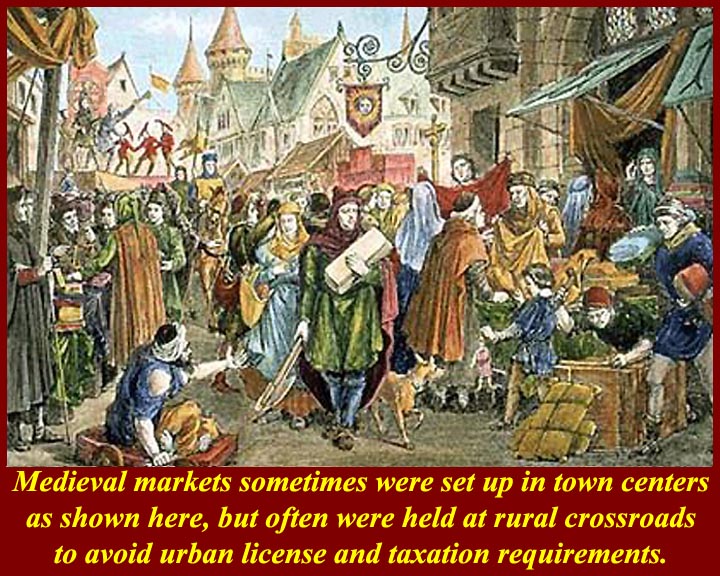
http://www.mmdtkw.org/MedRom0707x1MedievalFair.jpg
http://www.mmdtkw.org/MedRom0707x1ModernlFair.jpg
Medieval fairs, periodic gatherings of buyers and sellers, often were set up in town squares, but sometimes they assembled at exurban crossroads to avoid license fees and guild regulation.
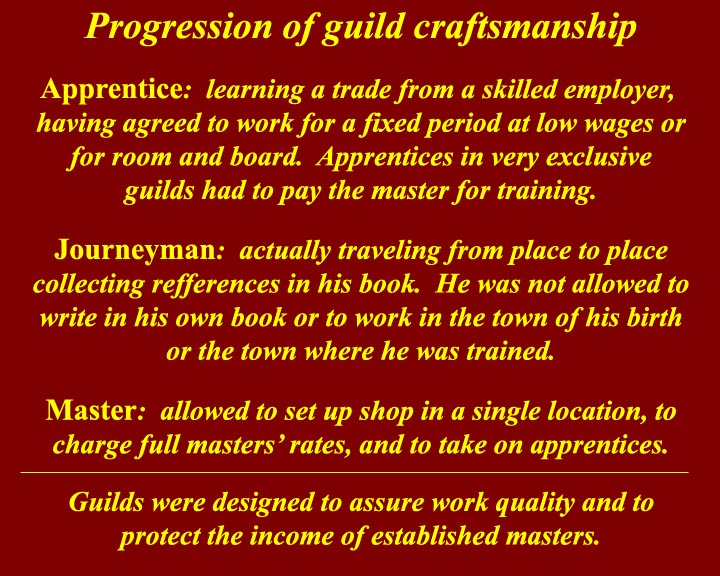
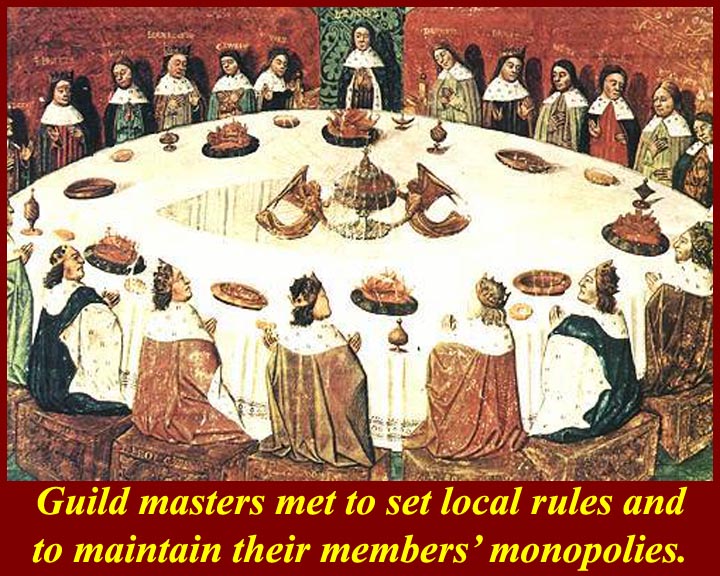
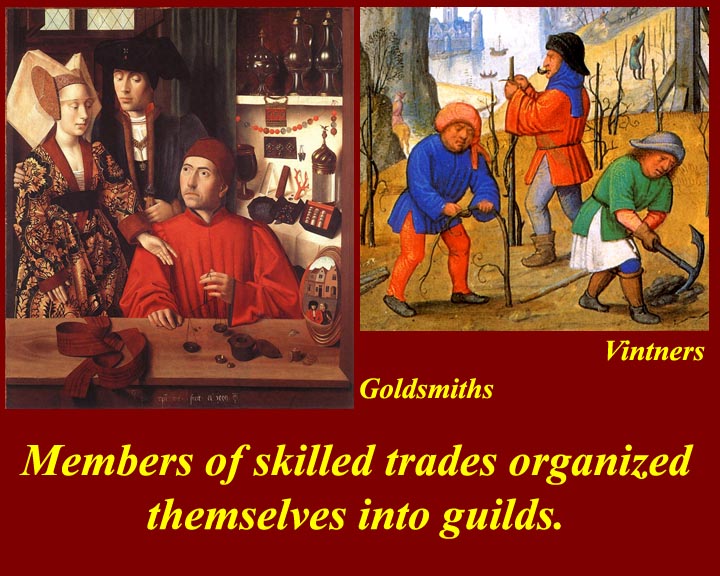
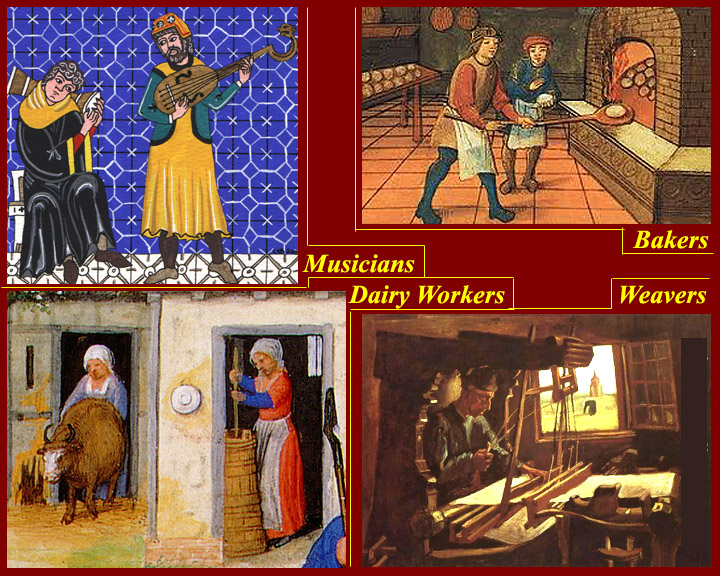
http://www.mmdtkw.org/MedRom0707x2CraftProgression.jpg
http://www.mmdtkw.org/MedRom0707x3GuildMastersMeet.jpg
http://www.mmdtkw.org/MedRom0707x4Vintners.jpg
http://www.mmdtkw.org/MedRom0707x5Musician.jpg
http://www.mmdtkw.org/MedRom0707x6LolipopGuild.jpg
Guilds had two avowed purposes, to perfect the quality of their goods and services and to protect their monopolies in given markets. The latter most often took precedence.
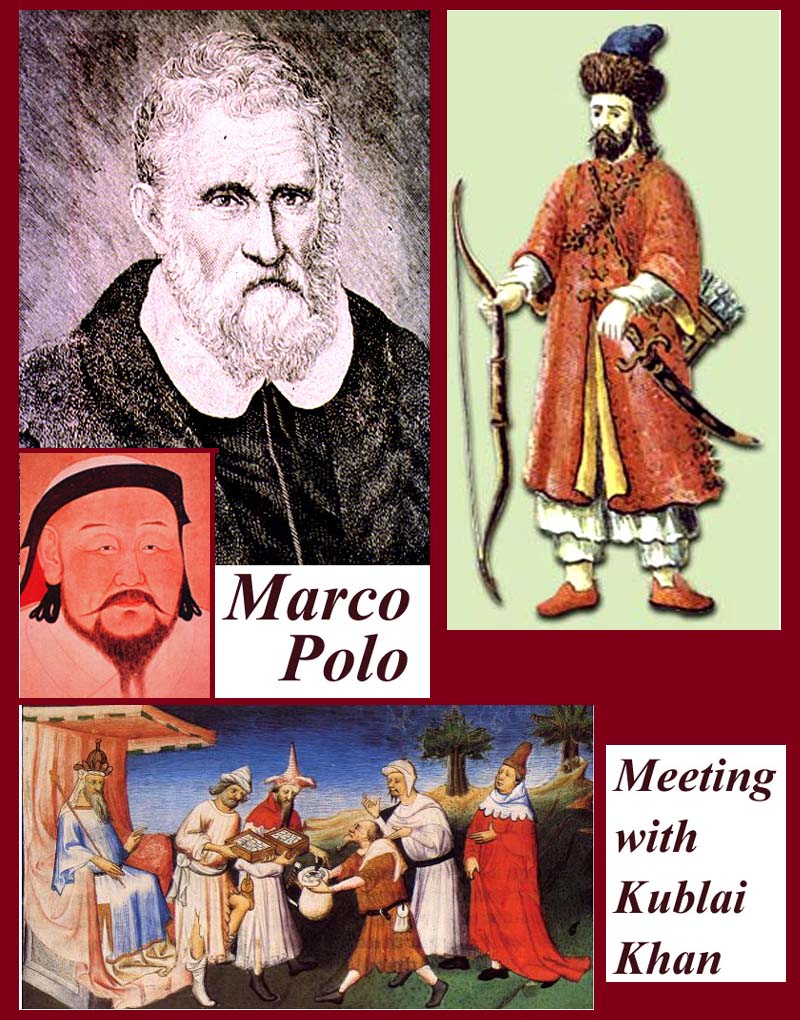
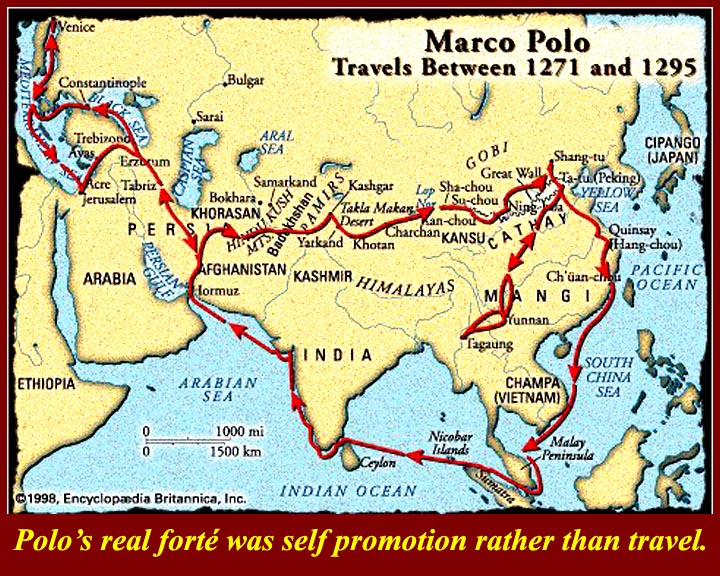
http://www.mmdtkw.org/MedRom0708MarcPolo.jpg
http://www.mmdtkw.org/MedRom0709aPoloMap.jpg
http://www.mmdtkw.org/MedRom0709aSilkRoad.jpg
Marco Polo traveled along the silk road as did others, but his press agentry made him the most famous of the medieval travelers/traders on that route.
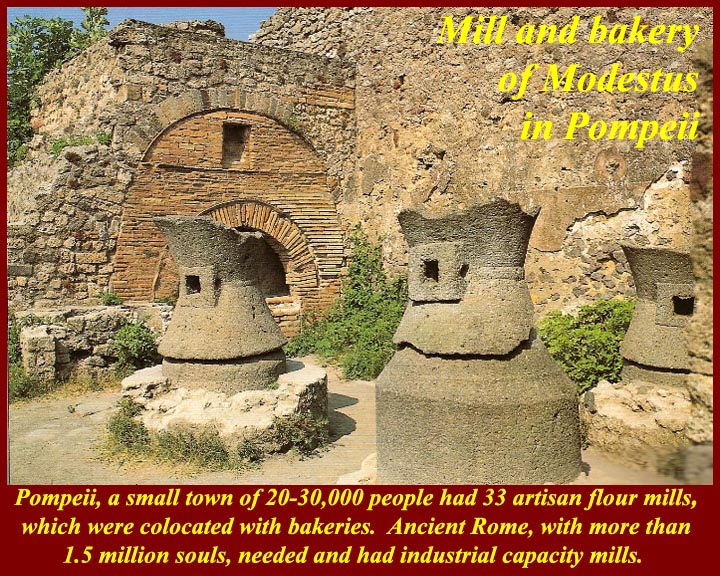
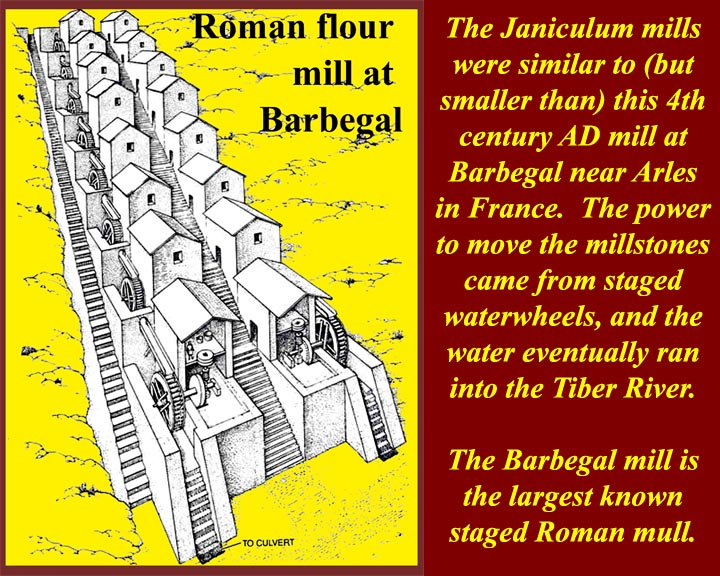
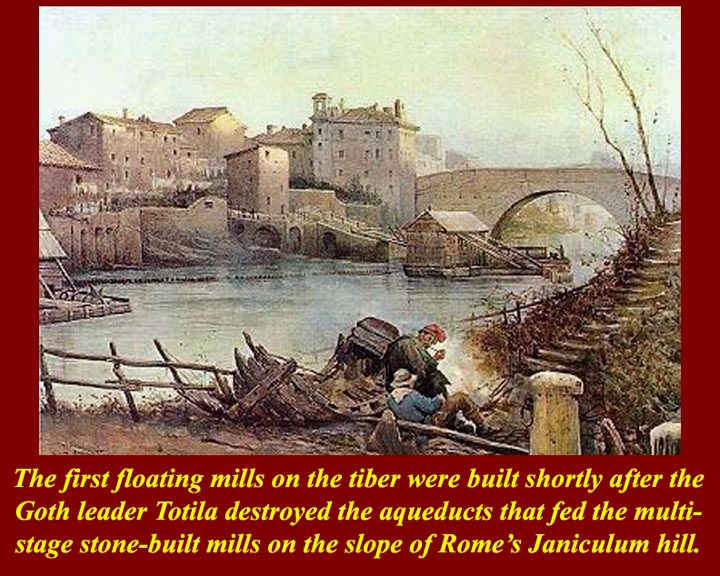
http://www.mmdtkw.org/MedRom0709bPompeiiMill.jpg
http://www.mmdtkw.org/MedRom0709cRomanMill.jpg
http://www.mmdtkw.org/MedRom0709dTiberMill1.jpg
http://www.mmdtkw.org/MedRom0709eTiberMill2.jpg
For centuries, Rome's largest and most importan industry was grain milling. Pompeii had more than 20 small artisan mills which were associated with bakeries, but big cities had to have industrial size mills. Rome's biggest known mill was a multi-wheel operation on the slope of the Janiculum Hill which was fed by an aqueduct. It wasn't as big as the one at Barbegal near Arles which is shown -- the Roman mill had only a single race. After Barbarians broke the aqueducts, replacement mills were mounted on barges in the Tiber River during the medieval period. The last Tiber River mill (photograph) was still in use until shortly before the dikes were built along the Tiber in the 1890s.
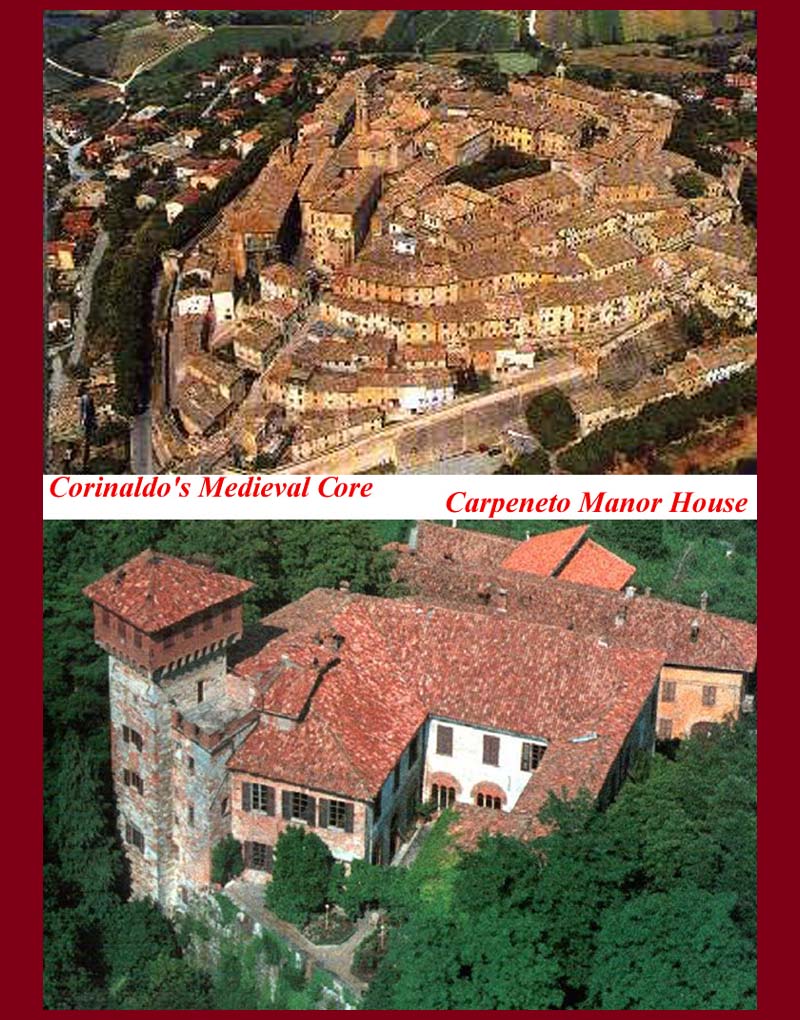
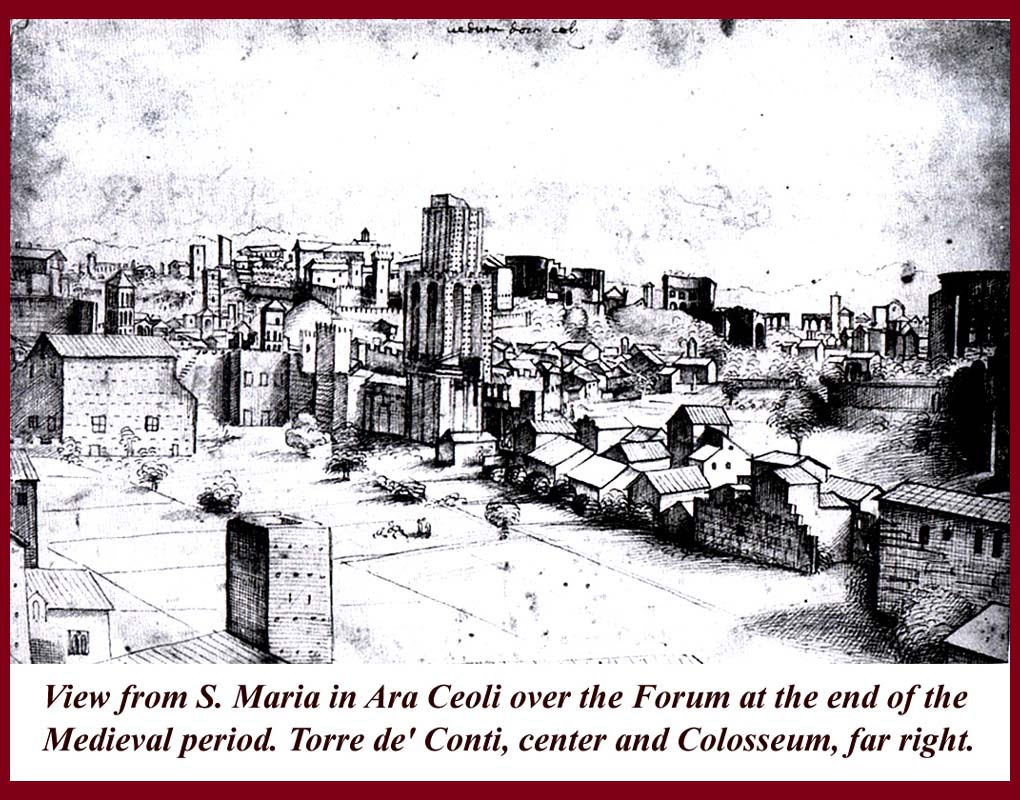
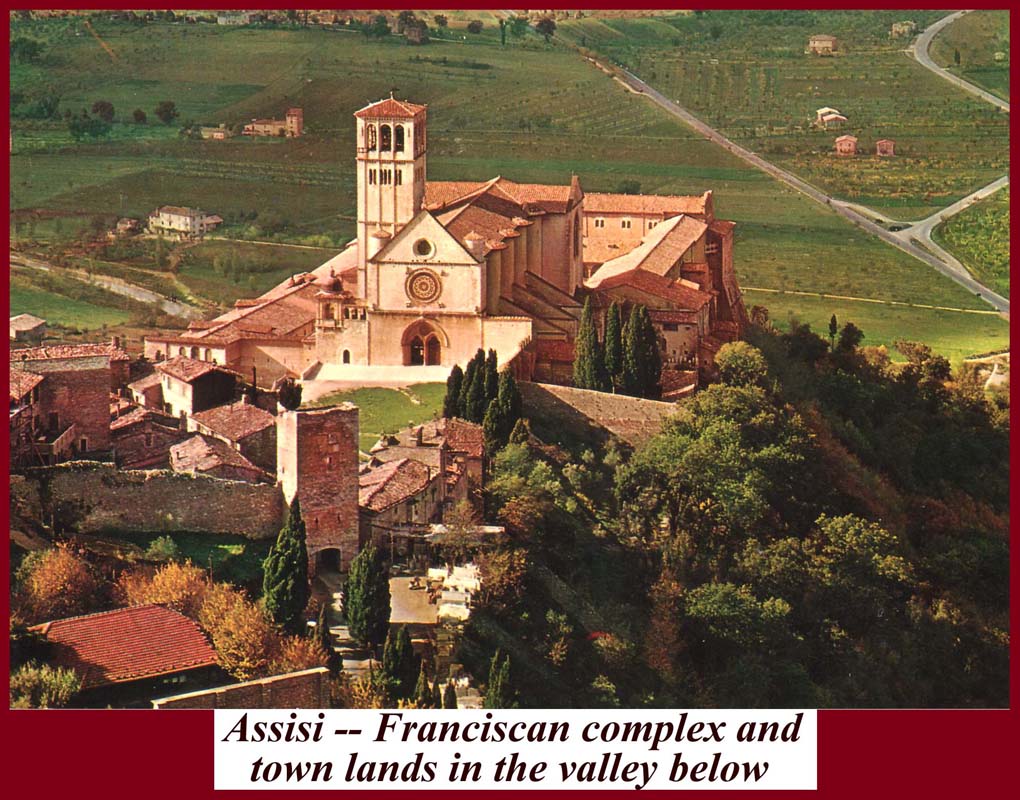
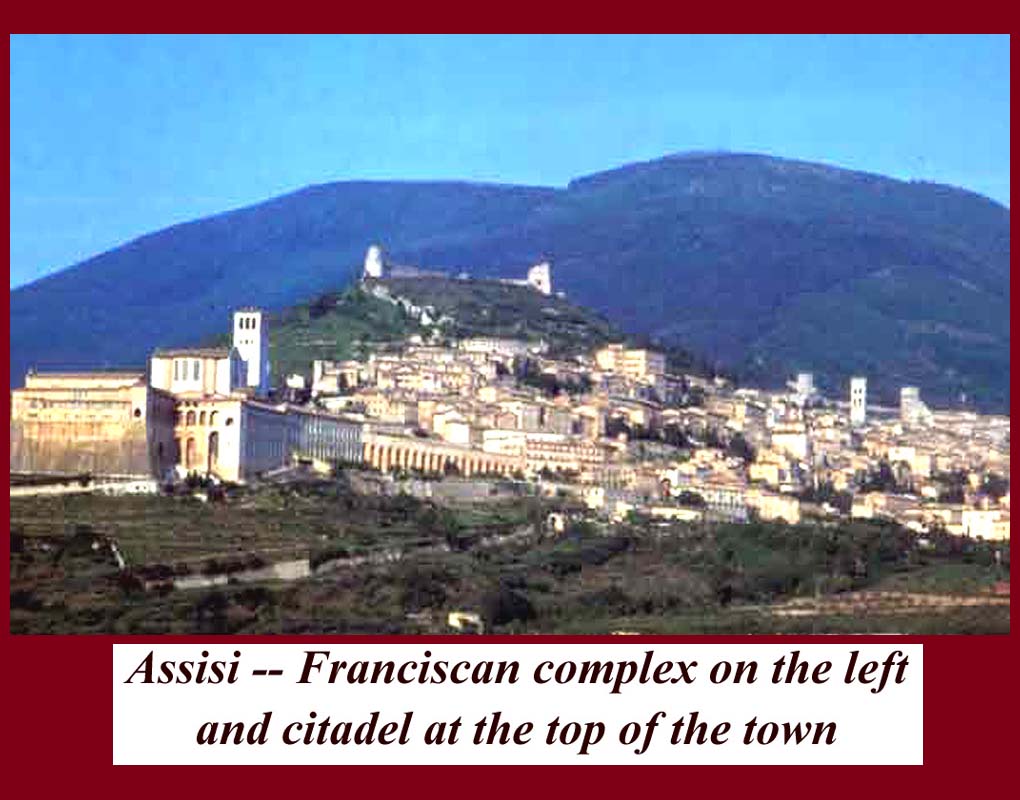
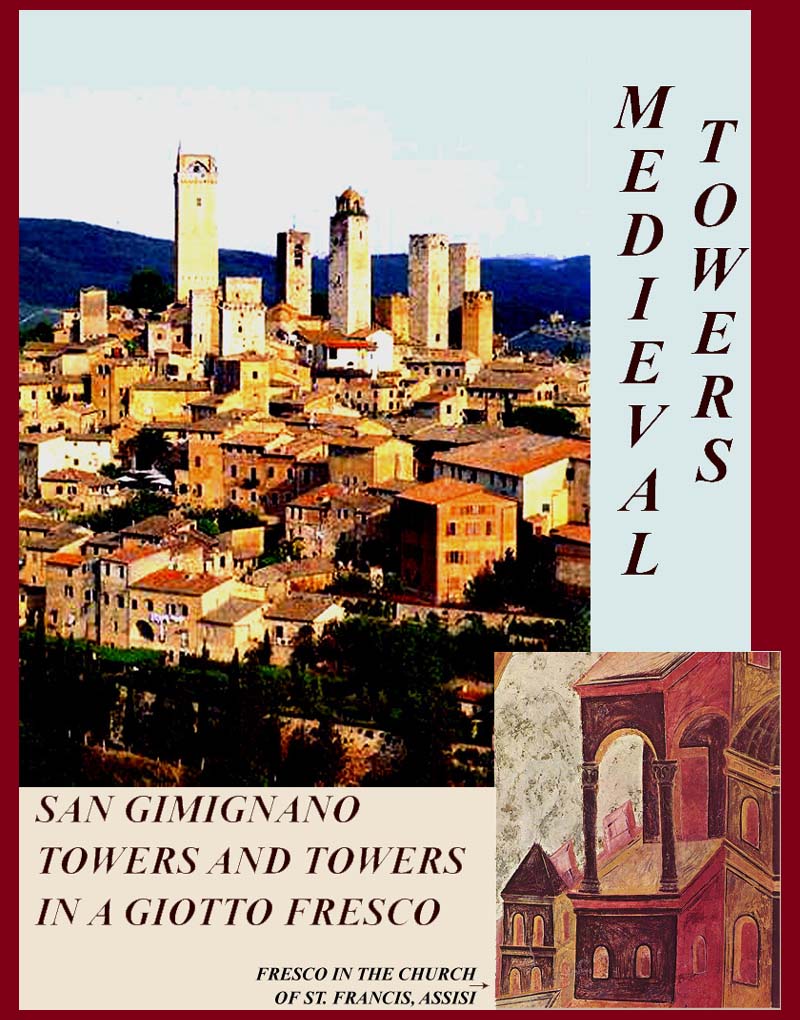
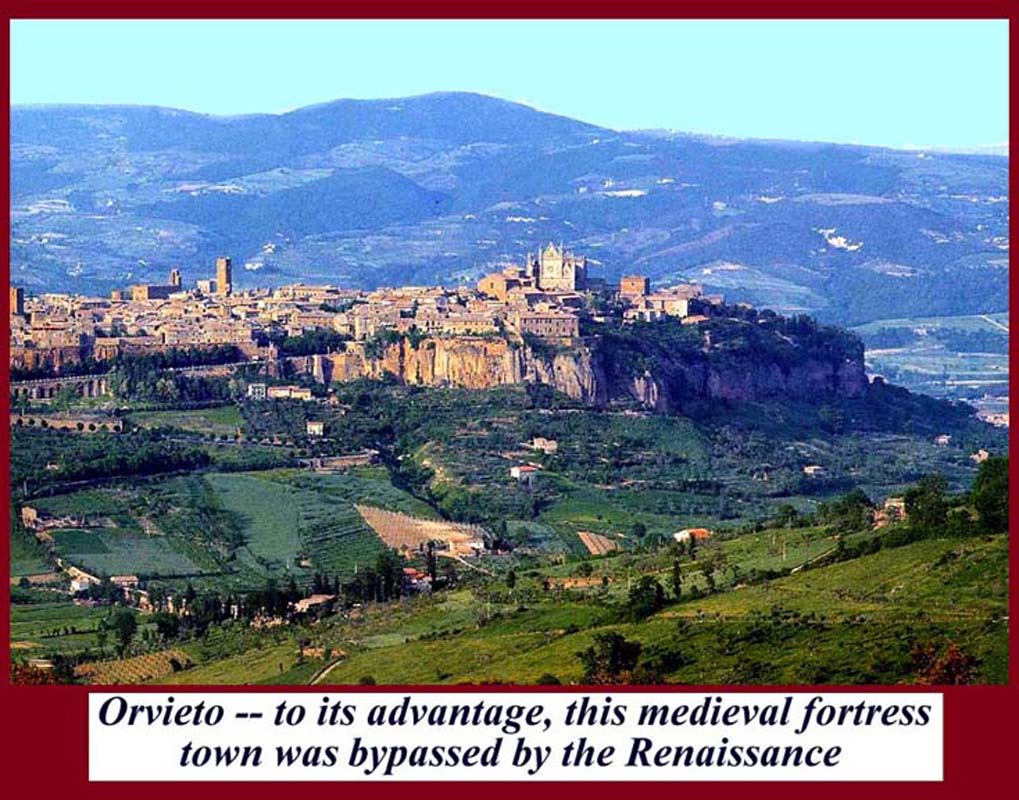
http://www.mmdtkw.org/MedRom0710CorinaldoCarpenet.jpg
http://www.mmdtkw.org/MedRom0711MedForum.jpg
http://www.mmdtkw.org/MedRom0712AssisiFranciscans.jpg
http://www.mmdtkw.org/MedRom0713ssisiTown.jpg
http://www.mmdtkw.org/MedRom0714GimignanoTowers.jpg
http://www.mmdtkw.org/MedRom0715Orvieto.jpg
http://www.mmdtkw.org/MedRom0716PalSenatorio.jpg
What money could buy. Towns, manor houses, churches, tourist towns, and municipal buildings were all built using the proceeds of trade in the expansive medieval Italian economy.

